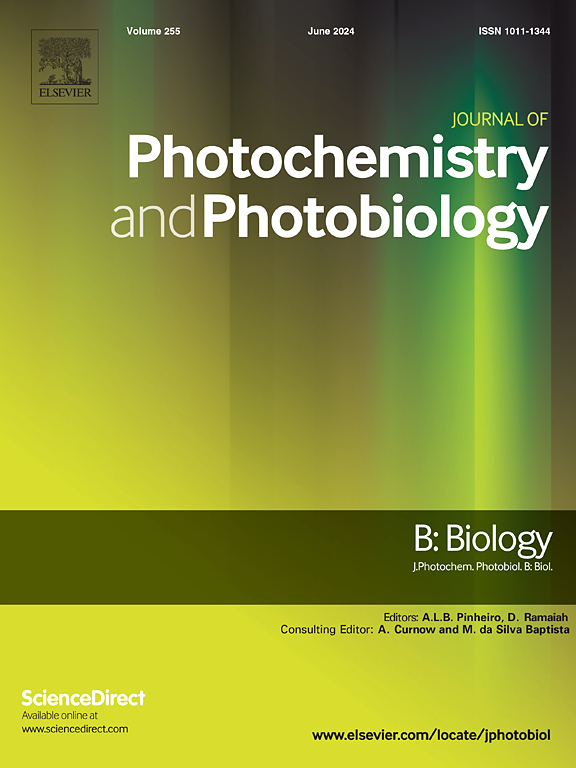Soranjidiol as a photosensitizer: Mechanistic insights into its photochemistry and photoinduced tautomerization
IF 3.7
2区 生物学
Q2 BIOCHEMISTRY & MOLECULAR BIOLOGY
Journal of photochemistry and photobiology. B, Biology
Pub Date : 2025-06-21
DOI:10.1016/j.jphotobiol.2025.113203
引用次数: 0
Abstract
This study employs computational chemistry to evaluate soranjidiol as a potential one– and two–photon photosensitizer in photodynamic therapy. Using density functional theory, its time–dependent counterpart, and molecular dynamics, the photophysical properties, phototoxicity mechanisms, and DNA intercalation were studied. The results reveal that neutral and anionic species are present in an approximate ratio of 57:43. The main one–photon absorption peaks are found in the blue–green region (446.4 nm and 564.3 nm, respectively) and correspond to nπ→π* types of excitations. High two–photon absorption cross–sections within the therapeutic window — 67.8 GM for the neutral form and 149.8 GM for the anionic form — strengthen their potential application in two–photon therapy as well. Through the network of reactions, the eventually reached lowest lying triplet have lifetime of 1.39 s (neutral form) and 1.57 μs (anionic form), both effectively harnessing type II photoactivity. In contrast, thermochemical and kinetic analyses underline that type I mechanisms are more relevant for the anionic form, while type III mechanisms dominate the activity of the neutral form. The analysis of 100 ns trajectories highlights that the neutral substance effectively intercalates DNA, while the anion is capable to bind CG–GC base pairs only. In most cases, the absorption profile alters, suggesting greater vulnerability of nucleic acids to photoexcitation after the process. The overall activity of soranjidiol is expected to be lower than that of aloe–emodin, which has been previously studied.
Soranjidiol作为光敏剂:其光化学和光诱导的互变异构的机理
本研究利用计算化学评价了soranjidiol作为光动力治疗中潜在的单光子和双光子光敏剂。利用密度泛函理论、时间依赖理论和分子动力学,研究了其光物理性质、光毒性机制和DNA嵌入。结果表明,中性和阴离子的比例约为57:43。主要的单光子吸收峰位于蓝绿色区域(分别为446.4 nm和564.3 nm),对应于nπ→π*激发类型。在治疗窗口内的高双光子吸收截面——中性形式为67.8 GM,阴离子形式为149.8 GM——也加强了它们在双光子治疗中的潜在应用。通过反应网络,最终得到的最低能级三重态的寿命分别为1.39 s(中性态)和1.57 μs(阴离子态),都有效地利用了II型光活性。相比之下,热化学和动力学分析强调I型机制与阴离子形式更相关,而III型机制主导中性形式的活性。100 ns轨迹分析表明,中性物质能有效插入DNA,而阴离子只能结合CG-GC碱基对。在大多数情况下,吸收谱会发生改变,这表明在此过程后核酸更容易受到光激发。soranjidiol的总体活性预计低于先前研究的芦荟大黄素。
本文章由计算机程序翻译,如有差异,请以英文原文为准。
求助全文
约1分钟内获得全文
求助全文
来源期刊
CiteScore
12.10
自引率
1.90%
发文量
161
审稿时长
37 days
期刊介绍:
The Journal of Photochemistry and Photobiology B: Biology provides a forum for the publication of papers relating to the various aspects of photobiology, as well as a means for communication in this multidisciplinary field.
The scope includes:
- Bioluminescence
- Chronobiology
- DNA repair
- Environmental photobiology
- Nanotechnology in photobiology
- Photocarcinogenesis
- Photochemistry of biomolecules
- Photodynamic therapy
- Photomedicine
- Photomorphogenesis
- Photomovement
- Photoreception
- Photosensitization
- Photosynthesis
- Phototechnology
- Spectroscopy of biological systems
- UV and visible radiation effects and vision.

 求助内容:
求助内容: 应助结果提醒方式:
应助结果提醒方式:


